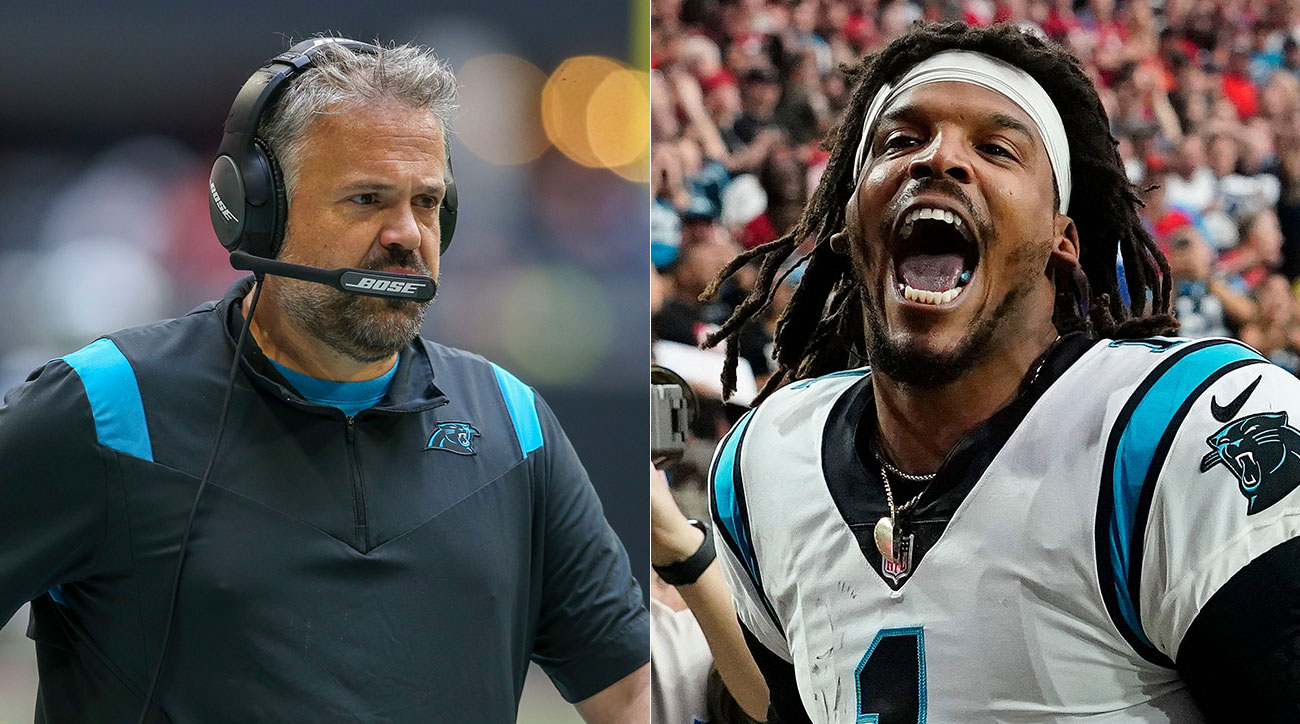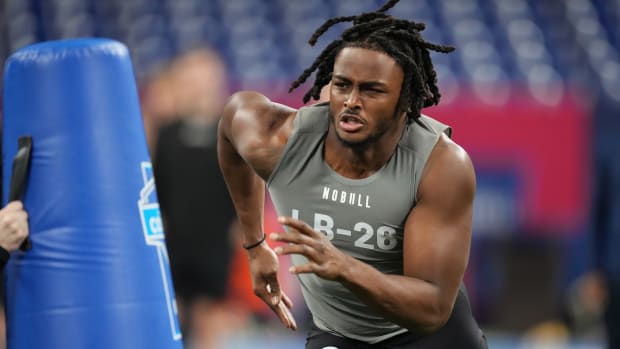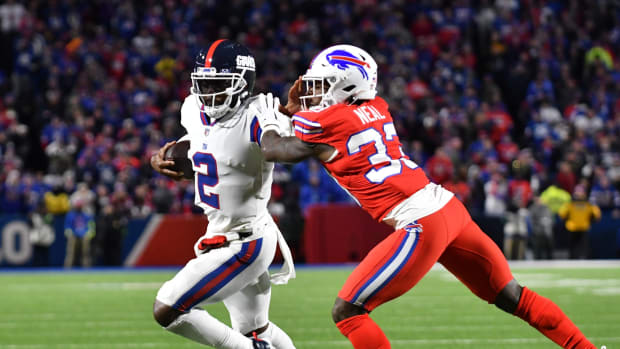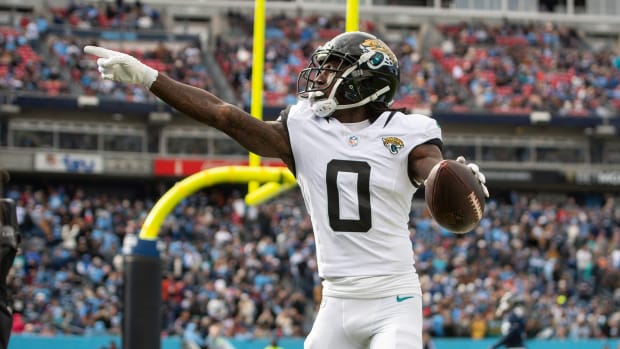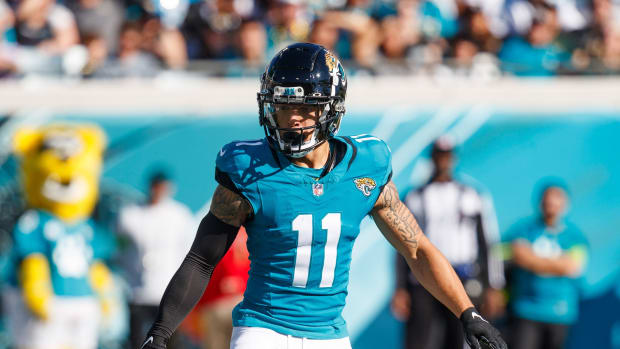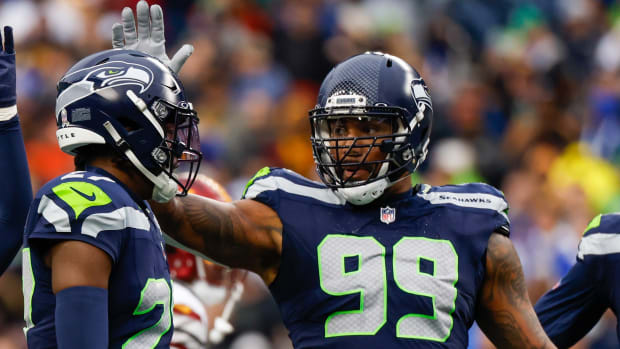GamePlan: How Cam Newton's Return Was Emblematic of the Panthers' Culture
Cam Newton’s “I’m back” moment on Sunday looked pretty simple on its face. The Panthers first took possession at the Cardinals’ 15 just 1:26 into the game, after a Haason Reddick strip-sack. On their fifth offensive snap, in went the new/old Carolina quarterback.
And in with Newton went Panthers coordinator Joe Brady’s play call—quarterback power, a run call that Newton’s executed hundreds of times. Newton took the snap, ran toward the line behind his fullback, then, lacking space there, bounced the play out to his right, and raced past the Arizona defense to the pylon to give Carolina a 7–0 lead. Three minutes later, a Newton touchdown pass to Robby Anderson would make it 14–0, and the Panthers were well on their way to a 34–10 road rout of a team that came in with the NFL’s best record.
So really cool, interesting reunion story, and that’s the end of it, right?
Not quite.
As Panthers coach Matt Rhule and I talked Thursday about where his team, and program, are, the play came up repeatedly. And Rhule hit on it most pointedly right when discussion turned to his April fishing trip with two-time Super Bowl–winning coach Jimmy Johnson
There were two big lessons Rhule said he took from the time he and his kid spent out in the Gulf of Mexico with the Cowboys legend. The first showed up in the simple act of getting Newton in the first place and doing it in November. “We talked about being willing, when you’re not a winning team yet, whether it’s trading, trading back, bringing in new players, just to do whatever it takes to bring in the players,” Rhule explained. “So that’s been my mentality; it’s been [GM] Scott [Fitterer’s] mentality.”
The second lesson was reflected in the Panthers’ going to Newton without fear on his first snap since preseason, then showing even more faith in him minutes later.
“Jimmy talking about finding a way to change momentum and win every game—How is the head coach impacting the game?” Rhule said. “It challenges me every week, O.K., just focus on this game, and what can I do as the head coach, and what can we do as coaches to give our guys a spark, to have some momentum. So it’s putting Cam out there and letting him run the quarterback power, knowing that if he scored, our entire team would be uplifted. And when he did and did again it was pretty special.”
“It takes guts for Joe Brady to call that sprint out with Cam never having seen him throw a pass—Joe Brady calling sprint out on the goal line on first down, he’d never seen Cam Newton put on a pair of shoulder pads and throw a pass. He hadn’t been in pads for us yet.”
Rhule’s now 26 games in as Carolina’s head coach. The Panthers were 5–11 last year and are 5–5 this year with seven games to go. No one’s arrived yet.
But signs that things are turning in Carolina are there if you look close enough. And while the dramatics of Newton’s effort as part of a huge win were always going to be the story coming out of that Week 10 game, how, why and even that it all went down this way can give you a pretty clear roadmap for where Rhule’s taking the Panthers in Year 2.
Week 11’s here, and 22 of the league’s 32 teams are now sitting between 6–3 and 3–6, which means we’ve got a big wide-open mess on our hands with Thanksgiving less than a week away. To sort the mess out, in this week’s GamePlan, we’re bringing you …
• A look at a fantastic headliner for Sunday’s action.
• A quick dive into the Buccaneers’ struggles.
• More horrific gambling advice (definitely fade my picks).
And with that, let’s get back to one of the NFL’s most interesting teams heading into the weekend.
On Sunday, arguably the most successful coach in Panthers history, Ron Rivera, returns to Charlotte, and what he’ll find barely resembles what he left behind after he and the team parted ways just two years ago. He’ll recognize the stadium—and not a whole lot else.
Newton’s return brought the number of players who played for Rivera on the Carolina roster back up to 12. And that only further drives home the point that Newton’s theatrical comeback last Sunday so vividly illustrated.
Rhule’s Panthers are constantly evolving, with the coach’s belief that they have to if they want to get to where they’re trying to go. It’s been apparent in where the season has taken the players and coaches, from a flashy 3–0 start to a wreck of a four-game losing streak, and now back to a promising place. It’s also evident, again, in how the brass is relentlessly tweaking and reworking the roster, and how the coaches are showing how they’ve bought into the approach with how they’re using the pieces they’re given.
But all the same, the basic premise of Rhule’s plan has remained—he wants a tough, physical team, a brand that should be identifiable as its deployment is flexible.
“They’re two different things to me,” Rhule said. “The brand is who we are and what we stand for. I always tell our guys, it’s not what you do, it’s how you do it. Our brand, we want to be a tough, hard-nosed, physical, competitive team. To me, if that means we rush with three, then we rush with three. The tactics to get there, to me, are completely different than the strategy.
“We want to play great defense, we want to run the football, we have these strategic things we want to do. Now, if one week it’s two backs, I-formation power football then great. If the next week, like last week, it’s Cam Newton, P.J Walker zone read, good. Whatever it takes.”
And both things are starting to show up in different ways. Among them …
The team fought through the four-game losing streak. And to try to flesh out how that happened, I asked if it’s too simplistic to just assume his team had to learn how to win, after blowing leads in consecutive games to the Cowboys, Eagles and Vikings, then fading down the stretch against the Giants.
“I don’t think it’s too simplistic,” Rhule said. “I think there’s stages to it. First, you have to learn how not to lose. That’s the first step. You eliminate all the bad football, and that’s a step that not many people pay attention to—but bad teams do bad things. So trying to, number one, learn how not to lose and eliminate bad football. Number two, you have to learn how to win—you have to learn to excel in crucial moments.
“Bad teams will say, ‘Yeah, we lost, but we only lost by four.’ Well, that’s the difference. It’s the four or five points that matter.”
In Atlanta in Week 8, in the 19–13 win that snapped the losing streak, those points came with a 15-play, 65-yard drive in the fourth quarter, and those points were saved by a clutch interception thereafter from another new acquisition, Stephon Gilmore, to salt the win away. And the ability to win those points away from the Falcons showed, to their coach at least, that the Panthers are learning how to win, which only brings the next step.
“Then the final piece to that is learning how to consistently win, where you’re the same team every week,” Rhule continued. “You’re not up and down, high and low, emotional where we’re up for this game and down for that game.”
And part of being the same team every week is being able to withstand attrition. The Panthers’ losing streak kicked off right after a Week 3 win that cost Carolina star tailback Christian McCaffrey and corner Jaycee Horn. Things only got worse the next week in Dallas, with Shaq Thompson going down, which really tested how far the Panthers have come.
“You look at teams that have won for a long time,” he said, “and they’ll lose their starting quarterback, they’ll lose their starting safety, they’ll lose a bunch of players, and they’ll still win because there’s a standard in the building.”
Obviously, that wasn’t the Panthers here, at least not right away. But in the time it took to reset, there was growth.
Starting safety Juston Burris went down, and that opened the door for Sam Franklin, Sean Chandler and Teddy Robinson to get reps. Likewise, injuries blew up the offensive line, and that meant moving Dennis Daley from right guard to left tackle, Trent Scott from tackle inside to guard, Pat Elflein from guard to center, and waiver pickup Michael Jordan into the starting lineup.
Meanwhile, losing Horn led to the trade for former first-rounder C.J. Henderson, then another for Gilmore. Losing McCaffrey led the team to look at, then bring in Ameer Abduallah (who closed out the Arizona game by making a catch, like Gilmore had the Atlanta game), after Abdullah popped a kick return on Carolina for the Vikings in Week 6.
“It’s a completely new roster,” Rhule said. “We’ve had to redo everything, and I think it takes personnel people that are willing to scout and find not just what people can’t do, but what they can do, and then coaches that’ll play them.”
And with some of the injured guys coming back, the Panthers are now deeper for it.
From there, it’s been not just playing them, but figuring out a way to get the most of them. And this is where the tactics piece of Rhule’s philosophy comes in, and is probably best brought to life in the progress the run game has made over the last two months.
“To Joe’s credit first, early in the season, the controlled passing game, much like a West Coast offense, was a lot of our run game—throw the ball to Christian out of the backfield, those are the things that we had to do,” he said. “We beat Saints and we only ran for [89] yards. So we knew that was how we had to replace the run game. As Christian went down, and more because of the brand of football we wanted to play, we kept working on the run game, week in and week out.
“I mean, we’re out [practicing] in full pads, we’re in nine-on-sevens, we’re grinding away at the run game. And you could see it getting better. We weren’t getting the results that maybe we wanted on the scoreboard. We weren’t having 150-yard games. But we knew, listen, we’re getting better, we’re getting better, we’re getting better.”
Eventually, the Panthers got there, and in a big way. They rushed for 203 yards in the win over the Falcons without McCaffrey and 166 in the win over the Cardinals, with their star back in the fold. Similarly, defensive coordinator Phil Snow was adjusting to the losses of Thompson, Horn and Burris, and then the influx of corners.
Case in point—what was a heavy zone team last year on defense has become one that’s in man very regularly now, with the cover guys’ playing behind a bevy of five-man rush packages.
“Phil is a master at, O.K., who do I have and how can I utilize them to win this game?” Rhule said. “If we’re going, Hey, Shaq’s out, on passing downs, we’re gonna use five corners this week, because we have good corners, he’ll do it. If we need five D-linemen to stop the run, he’s going to do it. I mean, he’s gonna have a system, he’s gonna have things he believes in, but he also believes in players.”
And that, really, is the crux of all this.
In the end, Rhule keeps circling back to the job his players have done carrying all this out, because it takes a willingness on their part to do different things—whether that’s a guard like Daley moving outside, or a corner like Donte Jackson playing a different style than he was asked to a year ago.
Rhule, for his part, has long done things this way because he’s had to for most of his career, and can even remember it happening with Anderson back at Temple. Anderson left the team in 2014 for academic reasons, and upon returning in ’15, Rhule put him at corner, citing a need at the position. Three weeks later, with the Owls’ offense struggling and needing a spark, Anderson was back at receiver again.
“You don’t do that when you’re at Penn State,” said Rhule. “You don’t do that when you’re at LSU or Alabama. When you’re at Temple, you have a good player, you’re gonna utilize him. Nick Sharga was our starting fullback and our backup middle linebacker because I didn’t have enough players. When you’re at a place like Temple, you’re going to maximize the players. So when Cam Newton shows up on a Thursday, you’re like, ‘Well, if he can help us on 10 plays, maybe he can change the game on those 10 plays.’
“It’s uncomfortable sometimes, it’s unconventional, but that’s the background Phil comes from; that’s the background I come from. While we were at Baylor, I was also at Albright College. While we were at Baylor, Phil was also at Eastern Michigan, Laney College. We’ve come up through small schools. We have that approach.”
Rhule then paused and pointed out it’s not foreign to the NFL, either. “If you look at Bill Belichick, and he’s taking Troy Brown and playing him at corner, it just tells you, if the greatest coach in the history of football can do it, I’m not too good to do it too.”
But just the same as it was for Belichick with Brown, if Rhule doesn’t have a guy willing to do what Daley and Anderson were for him, then all the mission statements in the world won’t make it work.
“I’d give that credit to the players,” he said. “It’s really hard to have faith and believe in a process when you haven’t seen it work. So for me, I’m confident, because I’ve seen it, I’ve gone through it. But when you’re Shaq Thompson and you’ve been in Carolina, and all of a sudden there’s a new coach and he comes in from college and you go 5–11, then you have some success and it starts to waver, you could be like, Alright, is this really gonna work?
“It’s when the players buy into it that it works, and I gotta give credit really to the leadership on this team—Matt Paradis, Taylor Moton, D.J. Moore, Donte Jackson, Shaq Thompson—those guys, they’ve kept everyone stable. Hopefully we can get back-to-back wins. It’s been since the Houston game that we had back-to-back wins. So that consistency to me is the next step. We know how to win. Can we win consistently?”
In explaining it, Rhule mentioned that, indeed, the hope for taking that step follows closely how it played out for him at Temple and Baylor—tough first year, then an up-and-down second year with momentum building toward a breakthrough in Year 3.
The NFL’s tougher, of course. So there’s no guarantee that things will play out like that.
But in the nuance, rather than the flash of Newton’s return, there was yet another sign that the Panthers have every right to feel like they’re on their way.
FIVE-STAR MATCHUPS
1) Cowboys at Chiefs (Sunday, 4:25 p.m. ET): This game really does feel like it has it all. Young star quarterbacks. Teams with monster individual talents on both sides of the ball. Super Bowl–winning coaches, with head-coaching candidates on their respective staffs. Joe Buck and Troy Aikman are the winners here, for getting to call this one.
2) Steelers at Chargers (Sunday, 8:20 p.m. ET): Eleven of the 16 teams in the AFC are within a game and a half of each other (between 6–3 and 5–5), and these are two of them. Both are a half game out of first in their respective division races, and how this turns out could also play into tiebreakers for wild cards and seeding in January, too. And whether Ben Roethlisberger can clear the COVID-19 protocols before kickoff adds a layer of intrigue to a very big game.
3) Packers at Vikings (Sunday, 1 p.m. ET): Aaron Rodgers had his worst statistical performance since the opener last week—and there’s decent reason to give him a mulligan on that, seeing as though he hadn’t practiced all week. Presumably, he’ll have shaken the rust off and gotten enough work in by Sunday to give us a good midseason gauge of where Green Bay stands. And along the way, the Packers could do serious damage to the playoff hopes of their archrivals, for whom this one’s huge.
4) Colts at Bills (Sunday, 1 p.m.): Indy’s evolved to where its offense really is Jonathan Taylor’s offense, and that should provide the league’s top-ranked defense, and its No. 1 run defense, with a different sort of challenge. Meanwhile, Buffalo needs the win to stay ahead of the Patriots in the East, and any sort of conference win will be big for the Colts in chasing a wild card.
5) Cardinals at Seahawks (Sunday, 4:25 p.m. ET): Kyler Murray vs. Russell Wilson gets circled on the calendar from the minute it’s slotted in the schedule, but this edition is a little different. Murray’s playing status could go all the way up to kickoff, and the Cardinals just suffered their second loss. Meanwhile, Wilson’s coming off his own return to the lineup, during which he was shut out for the first time in his career. So someone’s going to come out of this one spiraling.
Watch NFL games online all season long with fuboTV: Start with a 7-day free trial!
FOUR THINGS TO FOLLOW
How the Buccaneers come out of their most pronounced slump in over a year. When we get to Monday night, Tampa will be 29 days removed from its last win (the bye week, of course, creates the fun with that number). So what gives? Well, after asking around, two things come up: one obvious, one less so. The obvious is the health of the secondary, which has affected an aggressive Buccaneer defense all year. The less obvious is the absence of Rob Gronkowski and Antonio Brown. In 2020, those two were treated, to a degree, like luxury items to top off a very rich arsenal of Tampa skill-position weapons. But with more time, they carved out roles, and had the advantage of having Tom Brady’s trust built in. So early this year, Brady started to rely on them in critical spots more. Which means that losing them, logically, would have an impact on the quarterback. That’s what other teams are seeing, anyway. And then there’s what one rival exec said to me about them, “They just look bored.” Maybe the MNF spotlight in New York will make them come alive.
Will that Patriots’ loss beat the Browns twice? Is it time to worry about the past coming back in Cleveland? The Browns are 2–4 in their last six, and really have just one lay-up left on their schedule. That comes this week, with the Lions heading to northeast Ohio. Now, the hope would be that over time, and with Nick Chubb, Kareem Hunt and Jack Conklin coming back into the lineup, Kevin Stefanski’s group will be able to reestablish the identity they rode to last year’s breakthrough 11–5 mark. Thing is, it hasn’t been who they’ve been of late. How do you measure that? Three of their last five opponents (Cardinals, Steelers, Patriots) have held them under 100 yards rushing, and three of their last six opponents (Chargers, Cardinals, Patriots) dropped more than 35 on them. Bottom line, if the bleeding doesn’t stop this week against the winless Lions, the conversation on this team will take a turn.
The Dolphins—yes, the Dolphins—have a shot to build momentum and get back in the AFC playoff chase. Again, yes, the same Dolphins team that was riding a seven-game losing streak earlier this month. Miami lost by three to Jacksonville and by two to Atlanta, and took Buffalo into the fourth quarter before the Bills pulled away from them on Halloween, before winning two in a row. So a couple breaks, and maybe they’d be 5–5 instead of 3–7. And beyond that, the rest of their schedule is very manageable. Their next five weeks: at Jets, Panthers, Giants, bye, Jets. So that’s three home games, with the one road trip coming this week against a team pulling Joe Flacco out of mothballs for his first significant action of the calendar year. If they win four in a row, they’ll be 7–7, with trips to Nashville and New Orleans preceding the season finale in Foxboro. Is 9–8 likely? Of course not. But it’s not impossible; and 9-8, in this year’s version of the AFC, might get you in. So let’s see what they do to Flacco and go from there.
How does Justin Fields look against Baltimore? The Chicago rookie’s finish in Pittsburgh two Monday nights ago was eye-opening—and clearly showed the upside he brings, in how he performed against a premier defense in a primetime game and a hostile environment. And now, coming out of his bye he gets one of the more complex defenses in football. This’ll be a good litmus test and perhaps a launching pad for Fields into the second half of his rookie year.
TWO BEST BETS
Season record: 6–14 (another 1–1 week in Week 10, which I’ll happily take).
Saints (+1.5) at Eagles: This line looks suspicious, right? I should probably be careful with it, right?
Cardinals (-2.5) at Seahawks: It’s possible that Seattle puts it all together in Russell Wilson’s second game back. More likely? This being a get-right game for Arizona.
ONE BIG QUESTION
Why are things so quiet on the coaching carousel?
We haven’t had a firing yet, or even much of a hint one could land in-season, and I think there are two things at work here. One, there’s the number we gave you earlier: 22 of 32 teams are between 6–3 and 3–6, which means fewer teams are dead in the water. Two, you don’t have the stay-of-execution coaches this year like you did last year in Atlanta, Detroit and Jacksonville. So it’s certainly possible things stay relatively quiet until January.
And until then? Until then, there are two things I’ll be keeping an eye on.
One, there are already a mountain of high-profile college openings and, by all accounts, a lack of obvious candidates at that level to fill them. It makes you at least wonder if any of the big schools will look to the pros to find candidates that have experience in college football and bring NFL cachet (like, say, Brady, Bills OC Brian Daboll or Cowboys DC Dan Quinn).
The one issue there would be timing. The new early signing period in college football is in mid-December, and that’s when most recruits wind up making their commitments official. Missing that period, for any incoming college coach, would be tough, and the NFL season, in the new 17-game format, doesn’t end until mid-January. Might a college program be willing to hire a guy in December and wait until January for him to show up? Sure, and it’s happened before (Bill O’Brien at Penn State, Charlie Weis at Notre Dame). But it’s not ideal.
(As an aside, I wouldn’t be surprised to see Washington kick the tires on Cowboys offensive coordinator Kellen Moore in the coming weeks, given Moore’s ties to ex-Huskies coach Chris Petersen.)
And the second thing I’m keeping an eye on? Whether more obvious candidates emerge over the next couple of months. Last year, guys like Arthur Smith and Robert Saleh were drawing interest for just about every team that had an opening. Who’s that guy this year? Daboll and Eric Bieniemy will be in the mix again, but there really aren’t the hot names new to the scene like there usually would be.
That make you wonder if second-chancers like Quinn, Patriots OC Josh McDaniels, Cardinals DC Vance Joseph, Buccaneers DC Todd Bowles or ex-Eagles coach Doug Pederson get a lot of run come January.
So all this should be interesting to follow, as always, over the months to come.
More NFL Coverage:
• NFL Must Take Idea of Fake Vaccine Cards Seriously
• Daily Cover: A Quarterback Evolution and Coaching Revolution
• The Seahawks Should Be Preparing to Trade Russell Wilson
• MMQB: Rodgers Returns, Other Packers Step Up
































